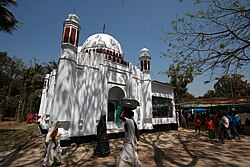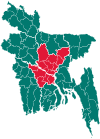Harirampur
হরিরামপুর | |
|---|---|
 Machain Shahi Jami Mosque | |
 | |
| Coordinates: 23°44′N 89°58′E / 23.733°N 89.967°E | |
| Country | |
| Division | Dhaka |
| District | Manikganj |
| Government | |
| Area | |
| • Total | 245.42 km2 (94.76 sq mi) |
| Population (2011) | |
| • Total | 139,318 |
| • Density | 570/km2 (1,500/sq mi) |
| Time zone | UTC+6 (BST) |
| Website | Official Map of Harirampur |
Harirampur (Bengali: হরিরামপুর) is an upazila of Manikganj District in the Division of Dhaka, Bangladesh.[1]
Geography
[edit]Harirampur is located at 23°44′00″N 89°58′00″E / 23.7333°N 89.9667°E. It has 33,513 households and a total area of 245.42 km2.
Demographics
[edit]According to the 2011 Bangladesh census, Harirampur Upazila had 33,513 households and a population of 139,318. 29,438 (21.13%) were under 10 years of age. Harirampur had a literacy rate (age 7 and over) of 48.39%, compared to the national average of 51.8%, and a sex ratio of 1117 females per 1000 males. 2,244 (1.61%) lived in urban areas.[2][3]
According to the 2001 Bangladesh census, Harirampur had a population of 171,274. Males constituted 84,994, and females 86,280.[4] The population of those aged 18 and older was 115,752. Harirampur had an average literacy rate of 30.2% (7+ years), against the national average of 32.4%.[5]
Administration
[edit]Harirampur Upazila is divided into 13 union parishads:
- Azimnagar
- Balara
- Balla
- Boyra
- Chala
- Dhulsunra
- Gala
- Gopinathpur
- Harukandi
- Kanchanpur
- Lesraganj
- Ramkrishnapur
- Sutalari
The union parishads are subdivided into 196 mauzas and 250 villages.[6]
Education
[edit]Colleges
[edit]- Jhitka Khawja Rahamat Ali Degree College
- M.A. Rouf Degree College, Kowri
- Government Justice Nurul Islam College
Secondary Schools
[edit]- Ibrahimpur Ishwar Chandra High School
- Jhitka Anando Mohan High School
- Jhitka Pilot Girls High School
- Patgram Anath Bandhu Government High School
- Diabari High School
- Jatrapur High School
- Ramkrishnapur M A Jalil High School
- Mohiuddin Kamol High School
Primary Schools
[edit]- Dorikandi Government Primary School
- Adhermanik Model Government Primary School
- Balurchar Government Primary School
- Bhatikandi Government Primary School
- Sutalori Government Primary School
See also
[edit]References
[edit]- ^ Manoranjan Mandal (2012), "Harirampur Upazila", in Sirajul Islam and Ahmed A. Jamal (ed.), Banglapedia: National Encyclopedia of Bangladesh (Second ed.), Asiatic Society of Bangladesh
- ^ a b "Bangladesh Population and Housing Census 2011 Zila Report – Manikganj" (PDF). bbs.gov.bd. Bangladesh Bureau of Statistics.
- ^ "Community Tables: Manikganj district" (PDF). bbs.gov.bd. 2011.
- ^ "Bangladesh Population Index". Population Census Wing, BBS. BGD Government. Retrieved 16 August 2013.
- ^ "Population Census Wing, BBS". Archived from the original on 2005-03-27. Retrieved November 10, 2006.
- ^ "District Statistics 2011: Manikganj" (PDF). Bangladesh Bureau of Statistics. Archived from the original (PDF) on 13 November 2014. Retrieved 14 July 2014.

Well, that’s interesting to know that Psilotum nudum are known as whisk ferns. Psilotum nudum is the commoner species of the two. While the P. flaccidum is a rare species and is found in the tropical islands. Both the species are usually epiphytic in habit and grow upon tree ferns. These species may also be terrestrial and grow in humus or in the crevices of the rocks.
View the detailed Guide of Psilotum nudum: Detailed Study Of Psilotum Nudum (Whisk Fern), Classification, Anatomy, Reproduction